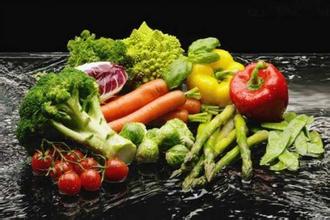So when you think big color, you know
想想什么叫顏色亮
we want purples like in blueberries and red cabbage
紫色藍(lán)莓,紅色卷心菜
we want carrots, we want you yams
胡蘿卜,番薯
everything that's colorful, is gonna tell you that there is more of those protectors
這些食物五顏六色,代表保護(hù)素更多
And then flavorful would include all of the onions and garlic cabbage family
味道重是說洋蔥,大蒜,卷心菜類
You could say arugula. I don't know how many of you shop at farmers market
再比如芝麻菜,不知道多少人去過農(nóng)貿(mào)市場
but when you get really fresh arugula
如果買到很新鮮的芝麻菜
it is like so peppery tasting. I don't know if you've noticed that
它會有辛辣的味道,不知道你們注意到?jīng)]有

That peppery taste is the sulfur compounds and they actually help to modulate your immune response in a good way
這種辛辣就是硫化物的味道能促進(jìn)免疫調(diào)節(jié)
So think of going for color and flavor
選擇顏色亮和味道重的食品
not only is a food for your eyes but it's also very health promoting
不僅是好看好吃,還有實(shí)際健康意義
So you can think of these phytochemicals as being the compounds that give color
可以認(rèn)為,植物素是為食品提供顏色
taste, smelling fragrance to the foods that we eat
口味和香味的物質(zhì)
But they're also very strong in antioxidants and anti-inflammatory factors
有很強(qiáng)的抗氧化性和抗炎性
and they increase detoxification enzymes in the body
并能增進(jìn)身體的解毒酶作用
And interestingly enough a little bit, well, not only soil quality
有趣的是,不僅少量土壤質(zhì)量變化
but also on a little bit of environmental stress
就算是少量環(huán)境變化
actually helps the plants to produce more
都能幫助植物產(chǎn)生更多
So you've heard of resveratrol which is found in red wine
聽過紅酒中的白藜蘆醇嗎
So the wine grape produces more of that when when it's attacked by fungi
在受到真菌攻擊時(shí),葡萄會產(chǎn)生更多白藜蘆醇
So a little bit of stressing of plants actually helps them make more of these protectors
少量的環(huán)境刺激,讓植物產(chǎn)生更多保護(hù)素
And when we eat them, then we get a little bit benefit or more benefit
我們食用時(shí),也會獲得更多好處
So along with thinking plant protectors
以上是植物保護(hù)素
I think it's really important that we make sure we get enough protein
下面看蛋白質(zhì),攝取足夠蛋白質(zhì)也很重要
to build and repair our tissue and to keep our immune system functioning optimally
這樣才能建造和修復(fù)組織,并保證免疫系統(tǒng)最優(yōu)化運(yùn)行
And we go both ways on protein I think
蛋白質(zhì)的問題兩種情況都有
Sometimes we're not getting enough and other times I think we're focused on getting way more than we need
有些人是攝取不足,另外一些人則是攝取過量
So keep in mind that you need somewhere kind of ballparking between 50 and 75 grams per day
正確的攝取量應(yīng)該是每天50到75克
And I put the slide together just so that you can do a little mental check
你們可以根據(jù)這張幻燈片的內(nèi)容檢查
as you look at your plate through the day
自己每天餐桌上的內(nèi)容
We think of meat, fish and poultry as being our protein foods and there are seven grams in every ounce
肉類,魚類,禽類是蛋白質(zhì)食物,每盎司含有7克蛋白質(zhì)
So what's an ounce? Like my finger
一盎司大概就手指這么大
Okay, that's a little piece of chicken; that an ounce
一小塊雞肉,一盎司
If you look at the palm of my hand, the palm of most of our hands is about 4 ounces
而手掌的面積大概是4盎司
So 4 times 7 would already be 28
4×7就已經(jīng)是28盎司
So if you had a piece of meat for dinner, you'd be half way there
一餐吃這么大一塊肉,一天的量就到了一半
If you're not doing meat and you're trying to get protein from beans
如果不是吃肉,而是從豆類攝取
which we are big advocates of that you get 7 g in 1/2 cup of cooked lentils or garbanzo beans or pinto beans
這是我們很主張的,每4盎司熟扁豆,鷹嘴豆,斑豆,含7克蛋白質(zhì)



